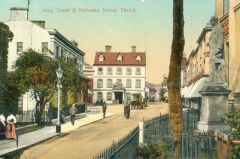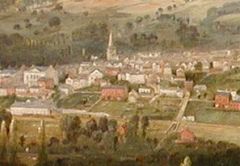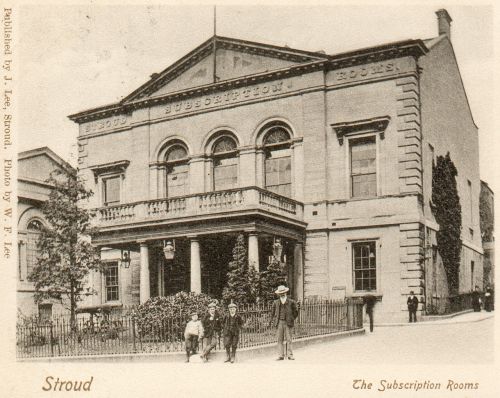
 |
 |
 |
 |
The place name 'Strode' is first recorded in the early thirteenth century: it has been suggested that it refers to a piece of marshy ground at the junction of the River Frome and the Slad Brook. A small settlement developed nearby in a natural location on a spur of the Cotswold Hills, at the point where several valleys converge and their watercourses drain into the Severn Valley. Originally a hamlet in the parish of neighbouring Bisley, Stroud had a chapel by the late 1200s. In 1304 it achieved parochial status. In the late fifteenth century a dozen or so houses were recorded and, by the early 1600s, it boasted both a fair and a market. During the following century and a half expansion was rapid and in 1779 it was linked to the Severn by the Stroudwater Canal. A decade later the Thames and Severn Canal was also opened, allowing for the transport of cargo eastward to the capital. Stroud became a Parliamentary Borough in 1832, returning two members. After 1845, when the railway arrived, the canals declined rapidly in importance. Agriculture apart, for centuries the traditional source of employment in the Stroud area was the woollen cloth industry - especially the manufacture of fine scarlet used for military uniforms. By the early nineteenth century, however, woollen cloth production had moved from its cottage-based origins into the complex of mills that line the valley bottoms and form such a distinctive feature of Stroud's industrial landscape. Adapting a machine used for cutting the nap on cloth, Edwin Beard Budding, early in the nineteenth century, invented the lawnmower, an example of which is to be seen in the new Museum in the Park. Other local industries included brewing, boat building at Brimscombe, carpet weaving, iron founding and quarrying the local oolitic limestone. Stroud's earliest buildings lie mostly along the upper High Street and on the hill slopes to which it leads. However, by the early nineteenth century, the focal centre of the town had moved downhill with the development of George Street and London Road, together with Russell Street and John Street - both named in honour of Lord John Russell, M.P. for the Division. Later Victorian town expansion led to the creation of Kendrick Street and Gloucester Street, both predominantly constructed in red brick. Among many buildings worthy of note in the town centre are the Station and Brunei's goods shed, the former Hill Paul and Co.'s clothing factory, the Subscription Rooms - built in 1833 to a design by George Basevi - and Bedford Street Congregational Church, which opened in 1837. The Parish Church of St. Lawrence, almost entirely rebuilt in the 1860s, and the Old Town Hall of around 1590 comprise an interesting group, together with the Shambles nearby, with its eighteenth century butchers' stalls. The School of Science and Art in Lansdown, 1899, is also an impressive structure. Mention might also be made of Sims' distinctive clock at the junction of George Street with Russell Street and the statue in Rowcroft commemorating clothing manufacturer, social reformer and M. P. George Holloway, who is credited with introducing powered sewing machines into Britain |